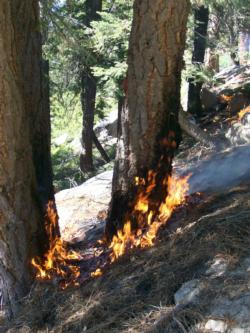Wildfire

Today, forest landowners and managers have varied strategies for dealing with wildfires. For example, the National Park Service has a mission to restore and maintain natural processes like wildfire and therefore will manage wildfires that ignite and burn under benign conditions, rather than suppress them immediately. On the other hand, private forest landowners view uncontrolled wildfire as a threat to their timber resources or homes, and so usually want wildfires suppressed as quickly as possible.
Other potential options for landowners is implementing prescribed fires or fuels reduction treatments.
Living in the forest or managing forest lands means anticipating and preparing for fire no matter what your management objectives are. For more background on fire and fuel management as well as some practices that can help reduce the risk of a catastrophic wildfire on forested property, please see the UCCE publication:
Forest Stewardship Series 15: Wildfire and Fuel Management (download)
Once a forested area has been burned in a wildfire, action by landowners is needed to assess the properties' conditions and whether actions such as replanting are needed. For more information on recovering from wildfire in a forested setting, please see the UCCE publication:
Recovering from Wildfire: A Guide for California's Forest Landowners (download)
Anyone living in California forested areas is living in a wildfire prone area. Residents are encouraged to prepare for wildfires by taking action ahead of time to reduce the risk of losing their homes to fire. Key to reducing risk is creating defensible space around homes and maintaining homes and upgrading home components to less combustible material. For more background on creating and defensible space, please see the UCCE publication:
Home Landscaping for Fire and Combustibility of Landscape Mulches (download)
For information on how to prepare your home itself to withstand wildfire and the flying embers that attack during fires, see the UCCE publication:
Home Survival in Wildfire-Prone Areas: Building Materials and Design Considerations (download)
More University of California Resources
Center for Fire Research and Outreach -The UC Berkeley Center for Fire Research and Outreach website contains on-line tools for assessing your home's construction design and materials for wildfire risk and gives specific suggestions for reducing risk. See:
Living with Fire in Tahoe - This collaboration between the University of California and the University of Nevada Cooperative Extension gives recommendations for reducing wildfire risk specific to residents of the Lake Tahoe Basin
Planned Herbivory in the Management of Wildfire Fuels (download)
Burned Oaks: Which Ones Will Survive? (download)
UCANR_Factsheet_Thinning_Defensible_Space
More Resources
The eXtension Wildfire Information Network is an interactive learning environment delivering the best, most researched knowledge from the smartest land-grant university minds across America.
The California Fire Science Consortium is dedicated to improving the quality and timeliness of two-way movement of fire science information between scientists, land managers, and stakeholders in the state’s fire community. Goals are to become a clearinghouse for all fire science resources relevant to the regions within the state of California, and to encourage collaboration between fire researchers and land managers and other stakeholders. Along these lines, we hope to make this website a centralized resource that can be used to both get access to and to better understand fire science, as well as to open new channels of communication and encourage the creation of applicable science.
California Fire Safe Council –The Fire Safe Council mobilizes Californians to protect their homes, communities and environments from wildfire by providing resources for establishing and maintaining local Fire Safe Councils, such as the FSC Handbook, nonprofit and funding information. The website can help you locate the fire safe council near you.
CalFIRE – The California Department of Forestry and Fire Protection or CalFire is the state's agency in charge with responding to wildland fires, provide training education and certification programs for the California Fire Service, and law and code enforcement and education.
CalFIRE published an issue of the Forestland Stewards Newsletter on the 2007 Angora Fire - Lessons Learned in Spring 2010.
2010 Forest and Rangeland Assessment Report – For more information on the wildfire threat to ecosystem health and community safety in California, see this 2010 CalFire assessment:
Maps
Maps of fire history, fire perimeters, and fuels - This like provides access to maps that show fuel and fire distributions in California. You can delineate the area you are interested in or use a pulldown menu of counties.
http://wildfire.cr.usgs.gov/calfireplan/viewer.htm (link)
Forest Health and Carbon Storage in the Sierra Nevada - System Indicators: A final report to the Sierra Nevada Conservancy, December 2012. This reports on the status of Sierra Nevada forests from the standpoint of health, fire and carbon storage.
